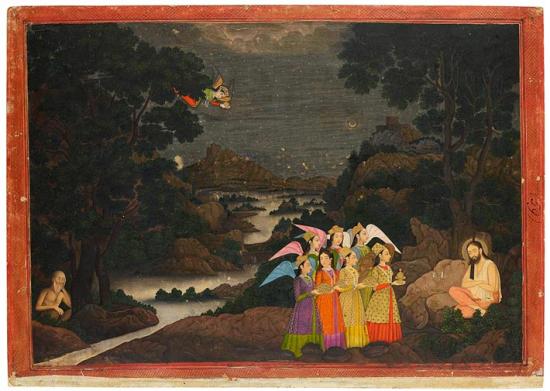
Ibrāhīm Ibn Adham of Balkh Served by Angels
From the Read Mughal Album, attributed to Mīr Kalān Khān
Purchased by Pierpont Morgan, 1911
After a spiritual awakening, Ibrāhīm Ibn Adham (d. 798), an eighth-century ruler of Balkh, renounced his kingdom and wealth to become a wandering dervish. Part of his spiritual awakening happened one night when he heard people on the roof of his palace. When he made inquiry, a man told him they were looking for a lost camel. Ibrāhīm then replied it was ridiculous to expect that the camel would be on the roof of his palace. The man then said it was equally crazy to expect to find Allah in the lap of luxury. Ibrāhīm then realized that his hope of finding Allah in his present surroundings was as futile as searching for a camel on his roof.
Rūmī (1207–1273), a later Sufi mystic, also born in Balkh, recounted Ibrāhīm's story in his six-volume poetic work, the Masnavī. Legend has it that Khiżr, the immortal guide of the Sufi, played a role and that Ibrāhīm, regarded as a spiritual ancestor of the Chrishtī Sufi order, was fed by angels. Here the haloed Sufi shaikh (spiritual master) sits at the right, with eyes closed and supported by a staff. Seven angels have already arrived, and an eighth is en route. A pensive man, at the far left, echoes the figure of Ibrāhīm.
The subject may have been inspired by engravings of Christ fed by angels in the wilderness. The painting is probably by Mīr Kalān Khān, who was active in Oudh and Delhi during the 1760s.
The Read Mughal Album
Pierpont Morgan purchased the Read Mughal album, along with a Persian album, from Sir Charles Hercules Read, Keeper of British and Medieval Antiquities at the British Museum, in 1911. The Morgan purchase consisted of thirty folios (including both Indian miniatures and the Mughal portraits presented here), but Read owned at least forty-eight others, now widely dispersed. The leaves were probably once bound in several lacquered bindings. The identity of their compiler has not been established, but many borders date from the eighteenth and nineteenth centuries. The Mughal emperors of India commissioned biographies and were frequently portrayed by artists. Here the paintings are presented in the order of the emperor's reigns rather than the dates of the miniatures, starting with Bābur (r. 1526–30), the Muslim founder of the dynasty, and ending with Shāh Jahān (r. 1628–58), builder of the Taj Mahal.
